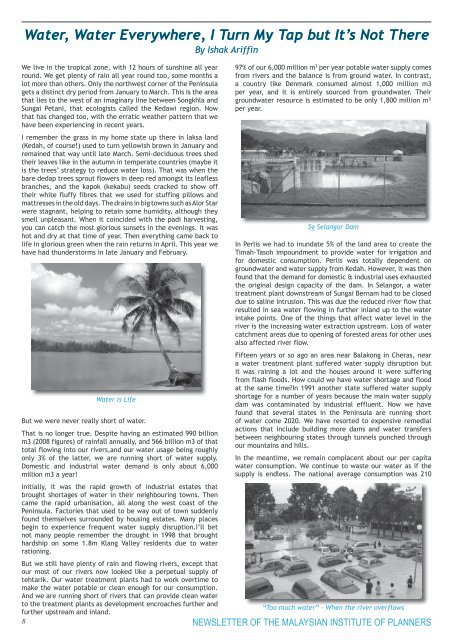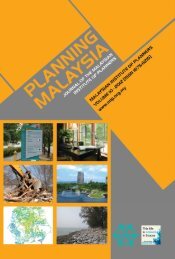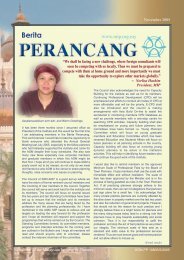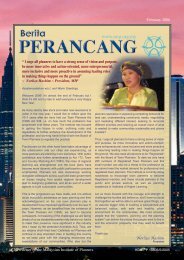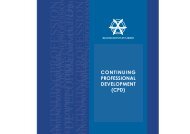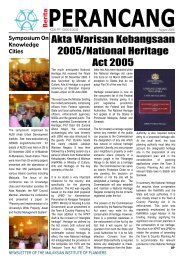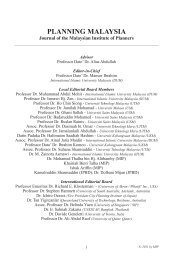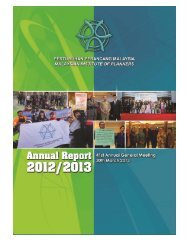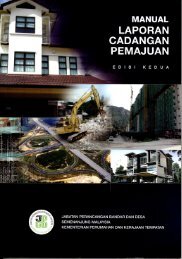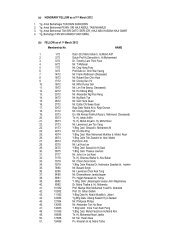mip patron tun dr mahathir mohamad honoured - Malaysian Institute ...
mip patron tun dr mahathir mohamad honoured - Malaysian Institute ...
mip patron tun dr mahathir mohamad honoured - Malaysian Institute ...
You also want an ePaper? Increase the reach of your titles
YUMPU automatically turns print PDFs into web optimized ePapers that Google loves.
Water, Water Everywhere, I Turn My Tap but It’s Not There<br />
By Ishak Ariffin<br />
We live in the tropical zone, with 12 hours of sunshine all year<br />
round. We get plenty of rain all year round too, some months a<br />
lot more than others. Only the northwest corner of the Peninsula<br />
gets a distinct <strong>dr</strong>y period from January to March. This is the area<br />
that lies to the west of an imaginary line between Songkhla and<br />
Sungai Petani, that ecologists called the Kedawi region. Now<br />
that has changed too, with the erratic weather pattern that we<br />
have been experiencing in recent years.<br />
I remember the grass in my home state up there in laksa land<br />
(Kedah, of course!) used to turn yellowish brown in January and<br />
remained that way until late March. Semi-deciduous trees shed<br />
their leaves like in the autumn in temperate countries (maybe it<br />
is the trees’ strategy to reduce water loss). That was when the<br />
bare dedap trees sprout flowers in deep red amongst its leafless<br />
branches, and the kapok (kekabu) seeds cracked to show off<br />
their white fluffy fibres that we used for stuffing pillows and<br />
mattresses in the old days. The <strong>dr</strong>ains in big towns such as Alor Star<br />
were stagnant, helping to retain some humidity, although they<br />
smell unpleasant. When it coincided with the padi harvesting,<br />
you can catch the most glorious sunsets in the evenings. It was<br />
hot and <strong>dr</strong>y at that time of year. Then everything came back to<br />
life in glorious green when the rain returns in April. This year we<br />
have had thunderstorms in late January and February.<br />
Water is Life<br />
But we were never really short of water.<br />
That is no longer true. Despite having an estimated 990 billion<br />
m3 (2008 figures) of rainfall annually, and 566 billion m3 of that<br />
total flowing into our rivers,and our water usage being roughly<br />
only 3% of the latter, we are running short of water supply.<br />
Domestic and industrial water demand is only about 6,000<br />
million m3 a year!<br />
Initially, it was the rapid growth of industrial estates that<br />
brought shortages of water in their neighbouring towns. Then<br />
came the rapid urbanisation, all along the west coast of the<br />
Peninsula. Factories that used to be way out of town suddenly<br />
found themselves surrounded by housing estates. Many places<br />
begin to experience frequent water supply disruption.I’ll bet<br />
not many people remember the <strong>dr</strong>ought in 1998 that brought<br />
hardship on some 1.8m Klang Valley residents due to water<br />
rationing.<br />
But we still have plenty of rain and flowing rivers, except that<br />
our most of our rivers now looked like a perpetual supply of<br />
tehtarik. Our water treatment plants had to work overtime to<br />
make the water potable or clean enough for our consumption.<br />
And we are running short of rivers that can provide clean water<br />
to the treatment plants as development encroaches further and<br />
further upstream and inland.<br />
8<br />
97% of our 6,000 million m 3 per year potable water supply comes<br />
from rivers and the balance is from ground water. In contrast,<br />
a country like Denmark consumed almost 1,000 million m3<br />
per year, and it is entirely sourced from groundwater. Their<br />
groundwater resource is estimated to be only 1,800 million m³<br />
per year.<br />
Sg Selangor Dam<br />
In Perlis we had to inundate 5% of the land area to create the<br />
Timah-Tasoh impoundment to provide water for irrigation and<br />
for domestic consumption. Perlis was totally dependent on<br />
groundwater and water supply from Kedah. However, it was then<br />
found that the demand for domestic & industrial uses exhausted<br />
the original design capacity of the dam. In Selangor, a water<br />
treatment plant downstream of Sungai Bernam had to be closed<br />
due to saline intrusion. This was due the reduced river flow that<br />
resulted in sea water flowing in further inland up to the water<br />
intake points. One of the things that affect water level in the<br />
river is the increasing water extraction upstream. Loss of water<br />
catchment areas due to opening of forested areas for other uses<br />
also affected river flow.<br />
Fifteen years or so ago an area near Balakong in Cheras, near<br />
a water treatment plant suffered water supply disruption but<br />
it was raining a lot and the houses around it were suffering<br />
from flash floods. How could we have water shortage and flood<br />
at the same time?In 1991 another state suffered water supply<br />
shortage for a number of years because the main water supply<br />
dam was contaminated by industrial effluent. Now we have<br />
found that several states in the Peninsula are running short<br />
of water come 2020. We have resorted to expensive remedial<br />
actions that include building more dams and water transfers<br />
between neighbouring states through <strong>tun</strong>nels punched through<br />
our mountains and hills.<br />
In the meantime, we remain complacent about our per capita<br />
water consumption. We continue to waste our water as if the<br />
supply is endless. The national average consumption was 210<br />
“Too much water” - When the river overflows<br />
NEWSLETTER OF THE MALAYSIAN INSTITUTE OF PLANNERS


